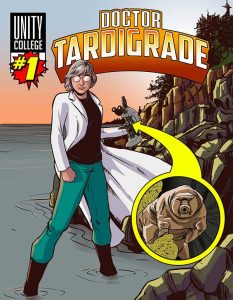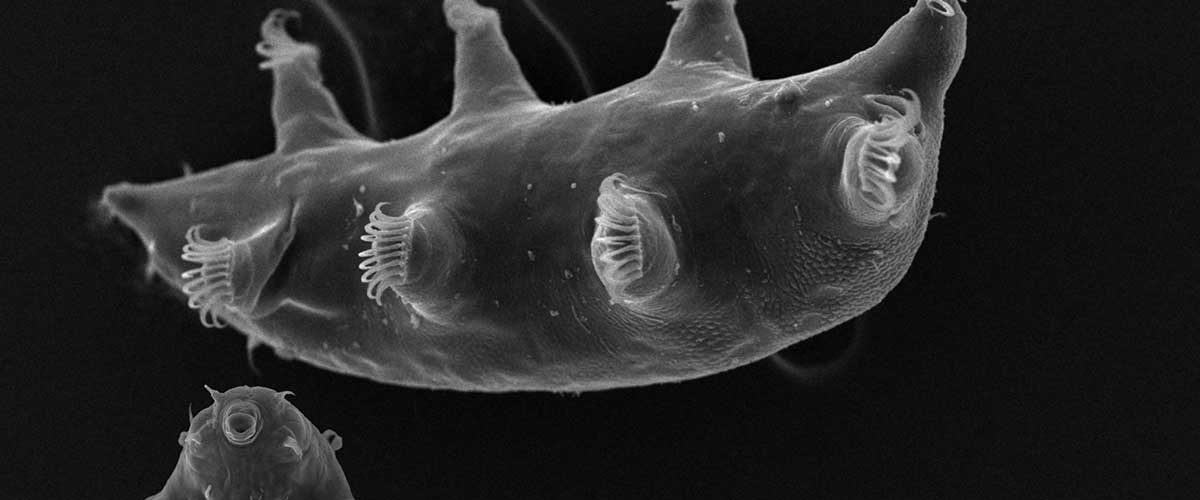Even as tardigrades make waves in pop culture, there is still much to be discovered about the world’s smallest known animal
Barnacles may be an odd — and smelly — parcel for most people to receive. But for Dr. Emma Perry, Professor of Marine Biology at Unity College, it’s exciting, presenting yet another opportunity to learn more about tardigrades, or possibly even discover a new species.
For those unfamiliar with tardigrades, commonly referred to as water bears, they are microscopic (.039 inches, on average), invertebrate organisms with eight legs. “They look like gummy bears with an extra set of legs,” Perry said. Though tardigrades have grown somewhat in popularity thanks in part to being featured in the recent Marvel blockbuster “Ant-Man and the Wasp,” they still receive little attention when it comes to research.
 Dr. Perry, however, is bringing tardigrade research to the forefront with her students, recently working with them to identify a new species of tardigrade. This tardigrade is the second that Dr. Perry has discovered with her class.
Dr. Perry, however, is bringing tardigrade research to the forefront with her students, recently working with them to identify a new species of tardigrade. This tardigrade is the second that Dr. Perry has discovered with her class.
“Imagine: You’re a young undergraduate interested in science, and you can contribute to discovering a new species of tardigrade. How cool is that?” said Dr. Melik Peter Khoury, President of Unity College. “Dr. Perry continues to give our students all kinds of opportunities to practice real science and real research, not just simulations in a classroom. It gives Unity College students new and practical skills in the sciences, which can easily be applied to their career or to further education.”
The newly described species is called Echiniscoides rugostellatus because of its rough back and star-like tips. In 2015, Perry and her students collected tardigrades on Allen Island, making national headlines by discovering a tardigrade species that is the same genus as this one. “This one is more integrated, in that we have scanning electron microscope images, we have slides, we also have DNA sequences, so that’s more than we had on the last one,” said Dr. Perry.
This particular tardigrade was collected by a colleague from barnacles off a pylon in Port Townsend, Wash. He scraped them up, wrapped them in a napkin, and shipped them to Dr. Perry. From there, Dr. Perry searched through the sample and removed any tardigrades.
 “We know very little about marine tardigrades, and even less about those on the West Coast than the East Coast,” said Dr. Perry. “The West Coast is almost unknown, in that you can count the number of West Coast tardigrade studies on one hand.”
“We know very little about marine tardigrades, and even less about those on the West Coast than the East Coast,” said Dr. Perry. “The West Coast is almost unknown, in that you can count the number of West Coast tardigrade studies on one hand.”
Tardigrades can be found all over the world, and are known for surviving in some of the harshest environments on Earth. Tardigrades have been found in the Antarctic, some of the highest mountaintops, and in the deep sea. They have even survived exposure to the space vacuum during a study by the European Space Agency.
The water bears have certainly been a hit with students. This summer, Sarah Neitzel, a Marine Biology major, even had the chance to present her work at the International Tardigrade Symposium in Copenhagen, Denmark. Neitzel evaluated the taxonomic status of the tardigrade Diphascon pingue brunvicense.
In addition to working with undergrads on research projects, Dr. Perry and her students recently helped middle-schoolers at the FM Gaudineer School in New Jersey with a project for NASA. The children’s interest in tardigrades was piqued, of course, after seeing them on the first season of “Star Trek: Discovery.”
As tardigrades continue to work their way into pop culture, young scientists have taken notice and are becoming increasingly interested in the micro-animals, as well as other facets of marine science. “Getting the word out about tardigrades helped us encourage these young women to get into science,” said Dr. Perry. “So, as long as it’s charismatic, for the most part, it’s all good.”
Meanwhile, as Dr. Perry continues to inspire and help guide her students in their classes and with their research, she patiently waits for the next slightly stinky package to arrive in the mail. It may very well contain yet another new species, just waiting to be discovered.
Dr. Perry’s 2015 presentation on her first discovery of a new tardigrade species:






